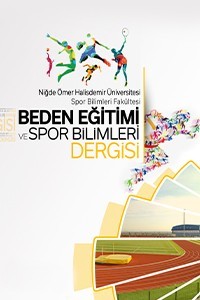SU ALTI YAĞ YÜZDESİ ÖLÇÜMÜ VE DERİ KIVRIM YÖNTEMLERİ İLE BELİRLENEN VÜCUT YAĞ ORANLARINDA FARKLI GÖZLEMCİ RAPORLARININ TUTARLILIĞI
Bu çalışmanın amacı, sualtı vücut yağ yuzdesine karsilik BF% için deri kıvrımı SK antropometri hassasiyetini araştırmak ve deri kıvrımı değerlendirmelerde cinsiyet farklılıkların ve grupici gozlemciler ve gözlemciler arası tutarlılık in olup olmadigini incelemktir. On erkek ve on kadın denek 5 ayrı deri kıvrım ölçümleri aldı, 5 ayrı gözlemcinin aldigi degerler değişkenliği bulmak için değerlendirildi. Pearson testi erkek ve kadın denek geçerliliğini değerlendirmek üzere bagimsiz olarak deri kıvrım ölçümleri ve sualtı tartım teknikleri arasındaki korelasyon test etmek için kullanıldı. Erkekler kadınlara göre grupici ve gözlemciler arasindaki tutarsızlık daha fazla miktarda olma eğiliminde olsa da, bu fark anlamlı değildi. Geçerlilik dikkate alındığında, deri kıvrım ölçümleri ve erkek ve kadınlar arasındaki sualtı arasında anlamlı bir fark yoktu. Değişkenlik gözlenen farklılıklar kadın ve erkek arasındaki deri kıvrımı sıkıştırılabilirliğinden kaynaklanan bir fark olduğu gerçeği ile açıklanabilir.
Anahtar Kelimeler:
Skinfold, Gözlemci varyasyonu, Sualtı tartım
DETERMINATION OF İNTRAOBSERVER AND İNTEROBSERVER VARİABİLİTY WITH THE ASSESSMENT OF UNDERWATER WEIGHING AND SKINFOLD MEASUREMENT METHODS12
The purpose of this study was to investigate the precision of skinfold SK anthropometry to evaluate percentage body fat BF % against underwater weighing UW and find out if sex differences in skinfold assessments would be apparent in intraobserver and interobserver consistency as well as validity when compared with underwater weighing UW measurements. Ten male and ten female subjects were assessed to find out intraobserver and interobserver variability by 5 separate observers who each took 5 separate skinfold measurements. Pearson test were used to test correlations between skinfold measurements and underwater weighing techniques for male and female subjects were plotted independently to assess validity. Although men tended to have greater amounts of intraobserver and interobserver inconsistency when compared with women, these differences were not significant. In consideration to validity, there was no significant difference between skinfold measurements and underwater weighing between man and women. The differences observed in variability could be explained by the fact that there is a difference in skinfold compressibility between men and women
Keywords:
Skinfold measurement, Observer variation, Underwater weighing,
___
- Cayton JR, Mole PA, Adam WC, Douglas DS. analysis Body impedance: effect of skin temperature. Med Sci Sport Exerc. 1988;10:489-491. by bioelectrical
- Eaton AW, Israel RG, O’Brien KF, Hortobagyi T, McCammon MR. Comparison of four methods to assess body composition in women. Eur J Clin Nutr. 1993;47: 353-360.
- Forbes GB. Human Body Composition. Springer Verlag, New York, 1987.
- Hayes PA, Sowood PJ, Belyavin A, Cohen JB, Smith FW. Subcutaneous fat thickness measured by magnetic resonance imaging, ultrasound and calipers. Med Sci Sports Exerc 1988;20(3):303-9.
- Heimmel J, Patel S, Cody R, Bachmann G. Evaluation of physical fitness in an ambulatory setting. Am J Obstet Gynecol 2007;196:522-3. Himes JH, Roche AF, Siervogel RM.
- Compressibility of skinfolds and the measurement of subcutaneous fatness. Am J Clin Nutr ;32:1734-40.
- Ketel IJ, Volman MN, Seidell JC, Stehouwer CD, Twisk JW, Lambalk CB. Superiority of skinfold measurements and waist over waist-to-hip ratio for determination of body fat distribution in a population-based cohort of Caucasian Dutch adults.Eur J Endocrinol 2007;156(6):655-61.
- Kispert CP, Merrifield HH. Interrater reliability of skinfold fat measurements. Phys Ther ;67(6):917-20. Kitano T, Kitano N, Inomoto T, Futatsuka M. Evaluation of body composition using dual-energy x-ray absorptiometry, skinfold thickness and bioelectrical impedance analysis in Japanese female college students. J Nutr Sci Vitaminol ;47 (2):122-5. Lee SY, Gallagher D. Assessment methods in human body composition. Curr Opin Clin Nutr Metab Care 2008;11(5):566-72.
- Lukaski HC. Methods for the assessment of human body composition: traditional and new. Am J Clin Nutr. 1987;41:364-370.
- Ostojic SM. Estimation of body fat in athletes: skinfolds vs bioelectrical impedance. J Sports Med Phys Fitness 2006;46:442-6.
- Webber J, Donaldson M, Allison SP, MacDonald IA. A comparison of skinfold thickness, body mass index, bioelectrical impedance analysis and dual energy x-ray absorptiometry in assessing body composition in obese subjects before and after weight loss. Clin Nutr. 1994;13:177-182.
- Weststrate JA & Deurenberg P (1989): Body composition in children: proposal for a method for calculating body fat percentage from total body density or skinfold-thickness measurements. Am. J. Clin. Nutr. 50, 1104–1115
- ISSN: 1307-6477
- Yayın Aralığı: Yılda 3 Sayı
- Başlangıç: 2007
- Yayıncı: Niğde Ömer Halisdemir Üniversitesi
Sayıdaki Diğer Makaleler
TÜRKİYE’NİN KIŞ OLİMPİYATLARINA MUHTEMEL ADAYLIĞININ DEĞERLENDİRİLMESİ* ERZURUM ÖRNEĞİ
AMATÖR FUTBOLCULARIN MÜSABAKA ANINDA KARAR VERME VE PROBLEM ÇÖZME KABİLİYETLERİNİN İNCELENMESİ
Yakup Akif AFYON, Mehmet DALLI, Sabri Can METİN, Erkan BİNGÖL
Nazmi SARITAŞ, Hanife ABAKAY, Mustafa KARAKUŞ, Betül COŞKUN
Bilal DEMİRHAN, Asim CENGİZ, Mehmet TÜRKMEN, Bade TEKBAS
SPOR YAPMANIN ENGELLİ BİREYLERDEKİ ÖZSAYGIYA ETKİSİNİN İNCELENMESİ
Erdoğan TOZOĞLU, Gökhan BAYRAKTAR, Serkan Tevabil AKA, Bülent TATLISU
Erkan YARIMKAYA, Mehibe AKANDERE, Gülsüm BAŞTUĞ
